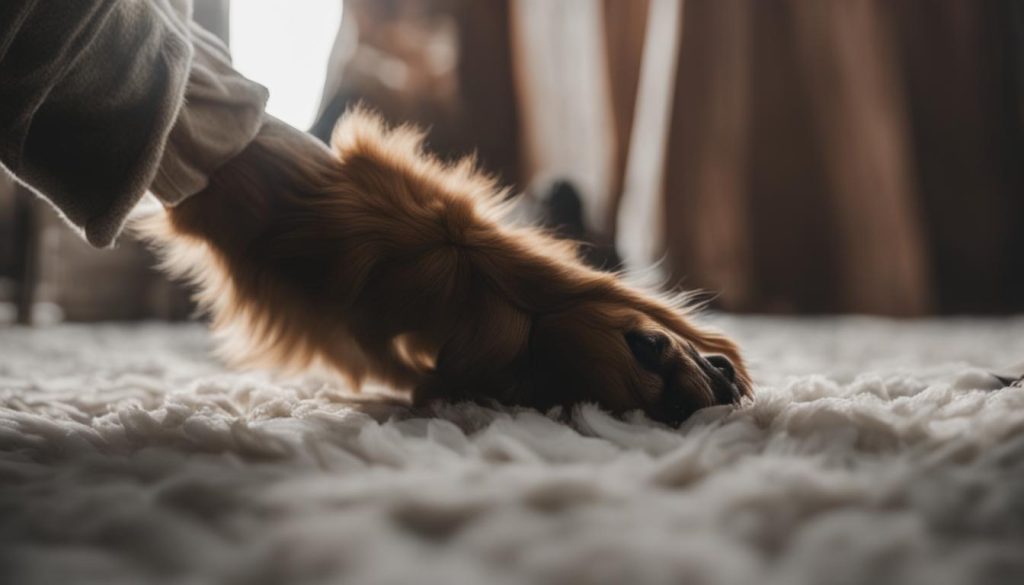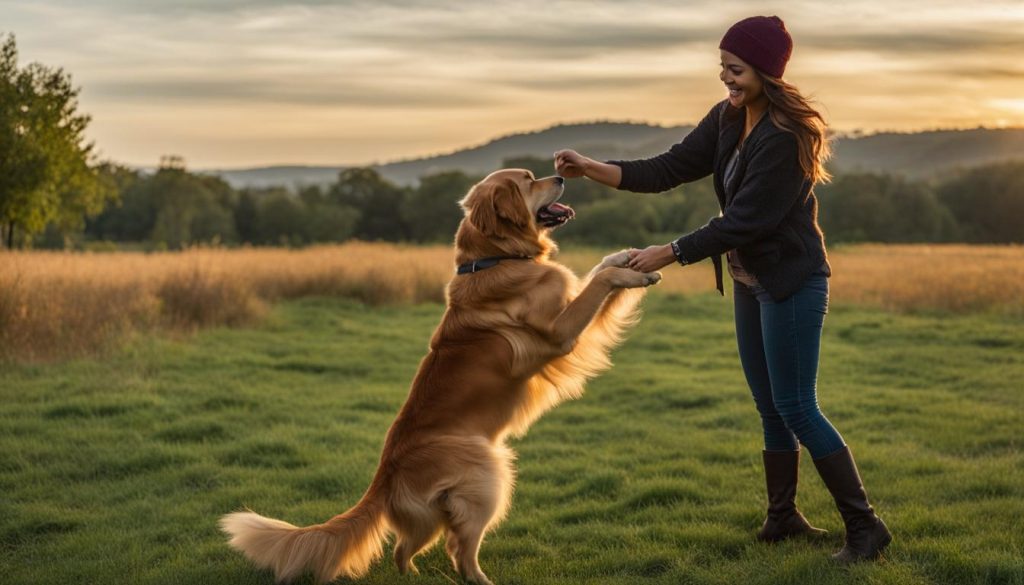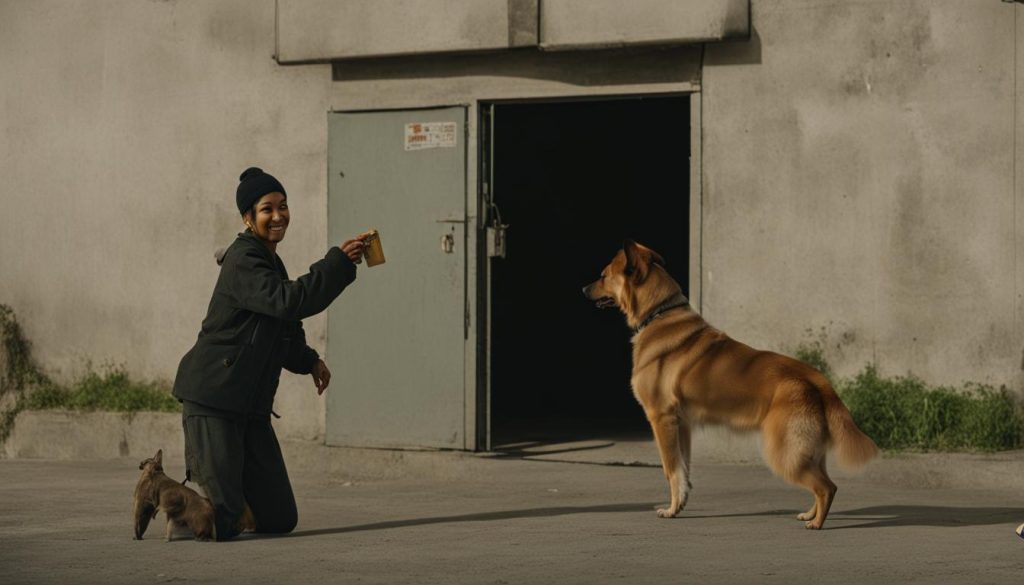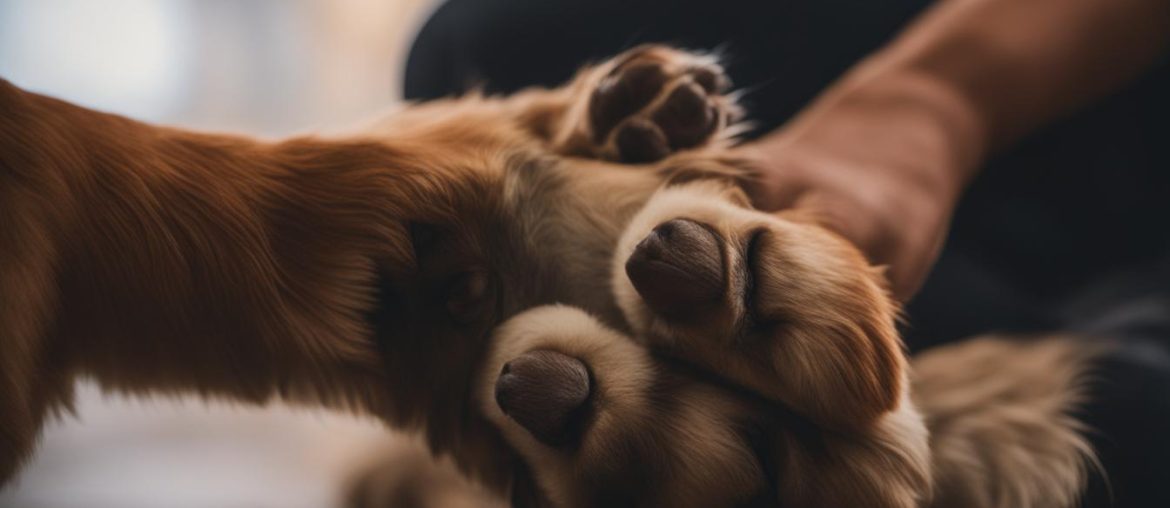When your dog paws you back, it may leave you wondering what this behavior means. Dog pawing is a common gesture that can hold different meanings depending on the context. As a dog owner, it’s important to understand your furry friend’s pawing behavior to better communicate and meet their needs.
Pawing can be a way for dogs to express their affection, seek attention, or indicate hunger or other needs. It can also be a result of their past experiences, particularly in sheltered dogs. To accurately interpret your dog’s pawing, it’s crucial to observe their body language and consider the overall context.
Key Takeaways:
- Pawing is a common behavior that can carry different meanings.
- Dogs may paw to express affection, seek attention, or indicate hunger or other needs.
- Understanding your dog’s body language and observing the context is crucial for interpreting their pawing behavior.
- Sheltered dogs may paw as a way to seek reassurance and express trust.
- Responding appropriately to your dog’s pawing can help strengthen the bond between you and your pet.
Dogs Pawing as an Expression of Love and Affection
When a dog paws at their owner, it can be a sign of love and affection. Just as humans pet their dogs to show affection, dogs reciprocate this gesture by pawing back. By extending physical contact through pawing, dogs are expressing their affection towards their owners. However, it’s important to consider the context and other body language cues to accurately interpret this behavior.
In order to decode a dog’s pawing, one must observe their overall body language. When the dog is engaged in a relaxed and positive interaction, such as cuddling or belly rubs, pawing is often a sign of reciprocated love and affection. The gentle touch of their paws can be a display of trust and a desire for a closer bond.
However, it is essential to pay attention to the dog’s cues and the surrounding environment. A dog’s pawing behavior may vary depending on the situation. For example, if a dog shows signs of anxiety, such as lip smacking, yawning, or flattened ears, pawing may indicate a need for reassurance and attention. By understanding the subtle cues and gestures, dog owners can better understand their furry friend’s intentions and respond accordingly.
| Pawing Behavior | Meaning |
|---|---|
| Pawing accompanied by wagging tail and relaxed body language | Expression of love and affection |
| Pawing with signs of anxiety, such as lip smacking or yawning | Seeking reassurance and attention |
| Pawing persistently and related to food | Indicating hunger or desire for food |
| Pawing during sleep | Seeking comfort and security |
Dogs Pawing to Seek Attention or Comfort
In some cases, dogs may paw at their owners to seek attention or comfort. This behavior can indicate their insecurity or anxiety, as they are looking for reassurance from their owners. Alongside pawing, dogs may exhibit other signs such as lip smacking, yawning, or flattened ears, which further indicate their need for affection and comfort.
Understanding the underlying emotions behind this behavior is vital for addressing their needs effectively. By providing them with the attention and reassurance they seek, dog owners can help alleviate their anxiety and create a sense of security. Ignoring their pawing may lead to increased distress and could potentially exacerbate behavioral issues.
Interpreting Body Language for Effective Communication
Interpreting a dog’s pawing behavior requires observing their overall body language and considering the context. When a dog engages in relaxed and positive interactions such as cuddling or belly rubs, pawing is often a sign of reciprocated love and affection. Conversely, if a dog displays signs of anxiety, such as lip smacking, yawning, or flattened ears, pawing may indicate a need for attention and reassurance.

By paying attention to these subtle cues and signals, dog owners can accurately decipher their furry friend’s message and respond accordingly. Building a strong bond with their dog involves understanding and meeting their needs, ensuring they feel loved and understood.
Understanding the Emotional Needs of Dogs
Pawing behavior is often a way for dogs to communicate their emotions and seek support. By interpreting their pawing and addressing their underlying needs, dog owners can help their furry companions feel safe, secure, and emotionally fulfilled.
Dogs Pawing to Indicate Hunger or other Needs
If your dog paws persistently, it may be trying to indicate hunger or other needs. While it’s important to address your dog’s needs, rewarding this behavior can lead to obesity and other health issues. Instead, establish a consistent feeding schedule to ensure their overall well-being. Additionally, dogs may also paw to communicate their need for playtime or physical activity.
| Pawing Behavior | Possible Meaning |
|---|---|
| Pawing at food bowl | Indicates hunger or desire for food |
| Pawing at the door | Signifies the need to go outside for bathroom or exercise |
| Pawing at toys | Expresses a desire to play |
It’s important to pay attention to your dog’s overall behavior and context when interpreting their pawing gestures. If you notice other signs of hunger, such as whining, pacing, or licking their lips, it’s likely that their pawing is related to food. However, if your dog is displaying signs of restlessness or boredom, they may be pawing to indicate their need for play or exercise.
Remember, it’s essential to establish a balance between meeting your dog’s needs and not reinforcing unwanted behaviors. By understanding and addressing their needs appropriately, you can ensure a healthy and happy relationship with your furry friend.
Understanding Context and Body Language
Interpreting a dog’s pawing behavior requires considering the context and observing their overall body language. When the dog is engaged in a relaxed and positive interaction, such as cuddling or belly rubs, pawing is often a sign of reciprocated love and affection. On the other hand, if the dog displays signs of anxiety, such as lip smacking, yawning, or flattened ears, pawing may indicate a need for reassurance and attention. Understanding these subtle cues is essential for accurately deciphering the dog’s message.
Additionally, it is important to pay attention to other body language signals that may accompany pawing. For example, if the dog’s tail is wagging and their body is relaxed, it is likely that the pawing is a friendly and playful gesture. However, if the dog’s body is tense and they are growling or showing other signs of aggression, pawing may be a warning sign or an attempt to assert dominance.
By considering the overall context and body language, dog owners can gain a deeper understanding of their furry friend’s intentions. This allows for more effective communication and a stronger bond between the dog and their owner.

Table: Body Language and Interpretation
| Body Language | Interpretation |
|---|---|
| Tail wagging, relaxed body | Friendly and playful pawing |
| Lip smacking, yawning, flattened ears | Seeking reassurance and attention |
| Tense body, growling | Warning sign or attempt to assert dominance |
“Understanding a dog’s pawing behavior goes beyond just looking at the pawing itself. It is crucial to consider the context and observe the dog’s overall body language to accurately interpret their message.”
By paying attention to these cues, dog owners can respond appropriately to their pet’s needs and create a harmonious and fulfilling relationship. Remember, every dog is unique, and understanding their individual body language is key to building a strong and trusting bond.
Dogs Pawing During Sleep
During sleep, dogs may exhibit pawing behavior for various reasons. It is important to understand that this behavior is driven by their natural instincts and can serve different purposes. Some dogs may paw at their owners in their sleep as a way to seek comfort and security. This behavior allows them to establish their own independent space while staying close to their human. It is a way for them to feel protected and warm.
While pawing during sleep is generally harmless, it is important to ensure that both you and your dog are comfortable. If your dog’s pawing becomes disruptive or makes it difficult for you to sleep, you may consider providing them with a designated sleeping space nearby. This can help satisfy their need for closeness while allowing you to have a peaceful night’s rest.

In some cases, a dog may paw at their owner to seek attention or comfort. This behavior can be a way for dogs to express their insecurity or anxiety and to seek reassurance from their owners. Signs such as lip smacking, yawning, and flattened ears may accompany pawing, indicating that the dog is seeking affection and comfort. Understanding the underlying emotions behind this behavior is crucial for addressing their needs.
“Pawing can be a natural way for dogs to communicate their affection and to seek attention,” says Dr. Emily Johnson, a canine behavior specialist. “It’s important for dog owners to pay attention to the context and accompanying body language to accurately interpret their dog’s intentions.”
- Pawing can be a sign of love and affection.
- Dogs may paw to seek attention or comfort.
- Understanding the context and body language is crucial for interpreting pawing behavior.
Additional Insights from Dr. Emily Johnson
Dr. Emily Johnson, a renowned canine behavior specialist, provides further insights into decoding a dog’s pawing behavior. According to her:
“Pawing can have different meanings depending on the dog and the situation. It’s important to observe the overall body language and consider other factors, such as the dog’s energy level, tail wagging, and vocalizations. By paying attention to these cues, owners can better understand what their dog is trying to communicate.”
Dr. Johnson advises dog owners to consider the individual characteristics and history of their dog when deciphering pawing behavior. Dogs with a history of shelter or abandonment may exhibit pawing as a way of seeking reassurance and trust from their owners. Taking these factors into account can lead to more accurate interpretations and better responses to a dog’s pawing behavior.
| Pawing Behavior | Meaning |
|---|---|
| Pawing with relaxed body language and wagging tail | Expression of love and affection |
| Pawing accompanied by lip smacking, yawning, or flattened ears | Seeking attention or comfort |
| Persistent pawing related to food | Indicating hunger or other needs |
| Pawing during sleep | Seeking comfort and security |
Professional Insights on Pawing Behavior
Interpreting a dog’s pawing behavior requires careful observation and understanding of their body language. While pawing can indicate various intentions and emotions, it is crucial to consider the overall context and accompanying cues to accurately interpret its meaning.
Consulting with a professional, such as a pet behaviorist, can provide valuable insights into decoding your dog’s pawing behavior. These experts emphasize the importance of observing the dog’s body language, including ear position, tail wagging, and mouth relaxation, to gain a comprehensive understanding.
According to pet behaviorists, pawing can serve as a form of communication for dogs. It can indicate affection and a desire for attention, or it may be a sign of anxiety, pain, or playfulness. Properly interpreting these cues is crucial for addressing your dog’s needs and ensuring their well-being.
“By paying attention to your dog’s overall body language and context, you can gain valuable insight into their intentions and emotions. This will enable you to respond appropriately and build a stronger bond with your furry companion.” – Pet Behaviorist
Creating a Strong Bond with Your Dog
Understanding and responding to your dog’s pawing behavior is crucial for building a strong bond with your furry companion. By acknowledging and meeting their needs, you can establish trust, deepen your connection, and ensure they feel loved and understood.
Responding with Patience and Affection
When your dog paws at you, it’s essential to respond with patience and affection. This gesture is often a way for them to communicate their needs or seek attention. By giving them the attention they are seeking, you can reinforce their trust in you as their caregiver. Whether it’s a gentle pat, a belly rub, or a simple acknowledgment, responding positively to their pawing behavior can help strengthen your bond.
Providing Mental and Physical Stimulation
Building a strong bond with your dog goes beyond physical touch. It’s important to provide them with mental and physical stimulation to keep them engaged and satisfied. Engage in activities such as interactive play, puzzle toys, or training sessions to keep their minds sharp and their energy levels balanced. By investing time and effort into their well-being, you demonstrate your commitment to their happiness and overall satisfaction.
Learning to Interpret Body Language and Cues
Understanding your dog’s body language and cues is key to building a strong bond. Pay close attention to their overall demeanor, facial expressions, and tail wagging patterns. This will help you decipher their emotions, needs, and desires. By actively listening and observing, you can respond appropriately and effectively, strengthening the communication between you and your furry friend.
Building a strong bond with your dog requires time, effort, and understanding. By responding to their pawing behavior with patience, providing mental and physical stimulation, and learning to interpret their body language, you can create a deep and meaningful connection. Remember, your dog relies on you for love, care, and guidance, and by meeting their needs, you can forge a lifelong bond filled with joy and companionship.

Wrapping Up
To summarize, understanding what it means when your dog paws you back is essential for building a strong bond and effective communication with your furry friend. Dogs use pawing as a way to express love and affection, seek attention or comfort, indicate hunger or other needs, and establish a deeper connection with their owners.
Interpreting your dog’s pawing behavior requires paying attention to the context, body language, and underlying emotions. By observing their overall behavior, such as lip smacking, yawning, or flattened ears, you can better understand their intentions and address their needs accordingly.
By responding appropriately and meeting your dog’s needs, you can foster a positive relationship based on trust and understanding. Remember to consult a professional if you encounter complex behavior patterns or have any concerns regarding your dog’s pawing behavior.
FAQ
What does it mean when your dog paws you back?
When your dog paws you back, it can be a sign of love and affection, a way to seek attention or comfort, indicate hunger or other needs, or establish a bond. Understanding the context, body language, and underlying emotions is crucial for accurately interpreting this behavior.
Why does my dog paw me?
Dogs may paw at their owners for various reasons, including expressing love and affection, seeking attention or comfort, indicating hunger or other needs, or establishing a bond. The meaning behind your dog’s pawing behavior can depend on the context and other body language cues.
How can I interpret my dog’s pawing behavior?
To interpret your dog’s pawing behavior, it’s important to consider the context, observe their overall body language, and understand the underlying emotions. Look for accompanying signs such as lip smacking, yawning, flattened ears, or other behaviors to accurately decipher your dog’s message.
What should I do if my dog paws me persistently for food?
If your dog paws persistently for food, it is important not to reward this behavior. Allowing your dog to determine when they receive food can lead to obesity and health issues. It is essential to establish a consistent feeding schedule for your dog’s overall well-being.
How can I create a strong bond with my dog?
Responding to your dog’s pawing behavior with appropriate attention and affection can help strengthen the bond between you and your furry friend. By showing understanding and meeting their needs, you can build trust and create a positive relationship. Consistently observing and interpreting their body language will enable you to respond effectively and ensure your dog feels loved and understood.






